
The Oath of Allegiance to the Flag of Peru is a military ceremony celebrated annually on 7 June (Flag Day) by the Peruvian Armed Forces. [1] [2]

The Oath of Allegiance to the Flag of Peru is a military ceremony celebrated annually on 7 June (Flag Day) by the Peruvian Armed Forces. [1] [2]
The text of the oath is as follows: [3] [4]
¿Juráis a Dios y prometéis a la Patria seguir constantemente a vuestra bandera, defenderla hasta perder la vida y no abandonar a vuestros superiores?
In English:
Do you swear to God and promise to the Homeland to always follow your flag, defend it until death and not abandon your superiors?
to which all present respond: "Sí, juro" (Yes, I swear). After the renewal of the oath, the National Anthem of Peru is played. [4]

The main ceremony takes place in the Plaza Bolognesi of Lima. Despite this, the swearing of the oath is celebrated in various other parts of Lima and other cities of the country, both by members of the Armed Forces and by civil authorities and public institutions. [3] [5] [6]
By the Supreme Decree of 8 November 1905 of the first José Pardo government, it was established that conscripts (citizens recruited annually into the Army) needed to perform the oath of allegiance to the flag in a public and solemn ceremony. [7]
By the Supreme Decree of 23 July 1923 (during Augusto B. Leguía's term) it was established that 7 June would be the selected date to swear the oath of allegiance to the flag in commemoration of the Battle of Arica, and that the ceremony in Lima should be performed in front of the Monument of Francisco Bolognesi in the plaza that also bears his name (inaugurated in 1905). [7]
The swearing of the oath is mentioned in the National Anthem of Peru, in which states "renovemos el gran juramento, que rendimos ... al Dios de Jacob" ("Let us renew the great oath, that we rendered ... to the God of Jacob").

The national flag of the Argentine Republic, often referred to as the Argentine flag, is a triband, composed of three equally wide horizontal bands coloured light blue and white. There are multiple interpretations on the reasons for those colors. The flag was created by Manuel Belgrano, in line with the creation of the Cockade of Argentina, and was first raised at the city of Rosario on February 27, 1812, during the Argentine War of Independence. The National Flag Memorial was later built on the site. The First Triumvirate did not approve the use of the flag, but the Asamblea del Año XIII allowed the use of the flag as a war flag. It was the Congress of Tucumán which finally designated it as the national flag, in 1816. A yellow Sun of May was added to the center in 1818.

The national flag of Uruguay is one of the three official flags of Uruguay along with the flag of Artigas and the flag of the Treinta y Tres. It has a field of nine equal horizontal stripes alternating white and blue. The canton is white, charged with the Sun of May, from which 16 rays extend, alternating between triangular and wavy. The flag was first adopted by law on 18 December 1828, and had 19 alternating stripes of white and blue until 11 July 1830, when a new law reduced the number of alternating stripes to nine. The flag was designed by Joaquín Suárez.
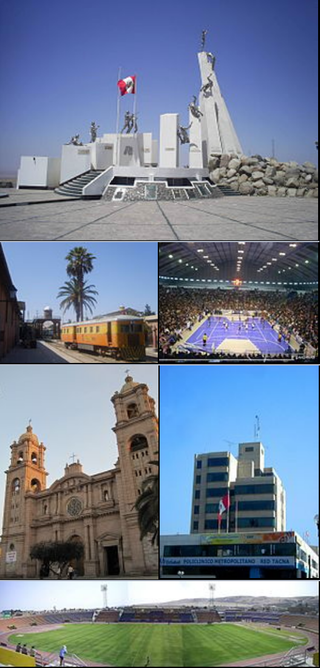
Tacna, officially known as San Pedro de Tacna, is a city in southern Peru and the regional capital of the Tacna Region. A very commercially active city, it is located only 35 km (22 mi) north of the border with Arica y Parinacota Region from Chile, inland from the Pacific Ocean and in the valley of the Caplina River. It is Peru's tenth most populous city.

Francisco Bolognesi Cervantes was a Peruvian military colonel. He is considered a national hero in Peru and was declared patron of the Army of Peru by the government of Peru on 2 January 1951.
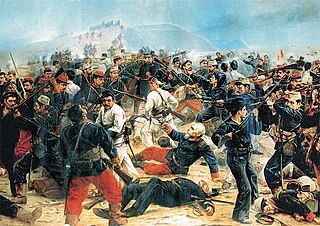
The Battle of Arica, also known as Assault and Capture of Cape Arica, was a battle in the War of the Pacific. It was fought on 7 June 1880, between the forces of Chile and Peru.

The flag of Macha is the name given to a pair of flags of Argentina found at a chapel in the hamlet of Titiri, near the village of Macha, north of Potosí, Bolivia. They are considered to be the first physical flags created by Manuel Belgrano, who in November 1813 hid the standards to prevent them from falling into enemy hands after the United Provinces' army defeat of Ayohuma. They were discovered in 1885. Bolivia kept one of those flags at Sucre; the other was given to Argentina in 1896 and is currently kept at the National Historical Museum. Tucumán Province has used it as provincial flag since 2010. The flag preserved in Argentina is a triband of blue, white and blue bands, like the modern flag of Argentina, but the one kept in Bolivia is a triband of white, blue and white.

José Juan de Dios Mateo Osbaldo Botaro Lepiani Toledo was a Peruvian painter. He is primarily known for historical and patriotic scenes; notably those related to the War of the Pacific.

The Plaza Bolognesi is a roundabout located in the Lima District and the Breña District, in the capital of Peru. It is located at the intersection of Brazil Avenue, Arica Avenue, Alfonso Ugarte Avenue, Guzmán Blanco Avenue, and 9 December Avenue.
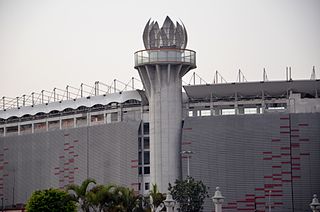
During the Parade of Nations at the 2019 Pan American Games opening ceremony, on July 26, 2019, 41 athletes bearing the flags of their respective nations led their national delegations as they paraded into Estadio Nacional in the host city of Lima, Peru
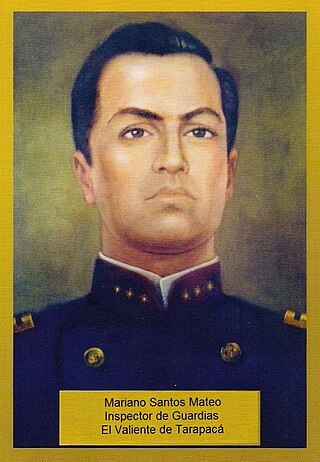
Mariano Santos Mateo was a Peruvian Civil Guard officer who fought in the War of the Pacific. He became famous by capturing, during the Battle of Tarapacá, the war ensign of the 2nd Infantry Regiment "Maipo" of the Chilean Army, for which he was nicknamed the Brave Man of Tarapacá.

Gustavo Petro's inauguration as the 34th President of Colombia took place on Sunday, August 7, 2022, marking the start of Gustavo Petro's four-year term as President and Francia Márquez as vice president. The 32nd presidential inauguration took place as usual in the central front of the National Capitol in Bogotá, D.C. Petro was sworn in as presidential oath, after which Márquez was sworn in as Vice President.

Peru–United Kingdom relations refers to the bilateral relations between the Republic of Peru and the United Kingdom of Great Britain and Northern Ireland. Relations between both countries date back to the British intervention in the Peruvian War of Independence.

The Flag Square is a public square in Lima, Peru. It is located next to the Mateo Salado Huaca at the intersection of Breña, Lima and Pueblo Libre districts.

La respuesta, also known as La respuesta de Bolognesi, is an 1891 oil painting by Peruvian painter Juan Lepiani. It forms part of the collection of the Combatants of the Morro de Arica Museum.

The Combatants of the Morro de Arica Museum, also known as the Casa de Bolognesi, is a house museum dedicated to the War of the Pacific and its battle of Arica, located at the birthplace of Francisco Bolognesi, in the historic centre of Lima, Peru.

Arica Avenue, formerly known as Breña Avenue, is a major avenue in Lima, Peru. It starts at the Plaza Bolognesi and crosses the districts of Lima and Breña until it reaches Luis Braille Avenue.
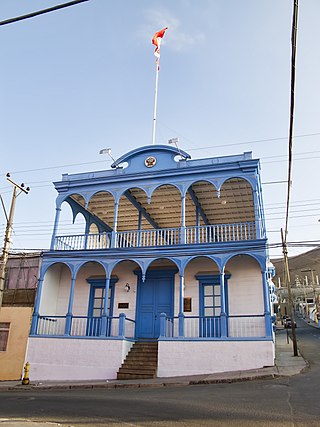
The Casa Bolognesi, also known as the Casa de la Respuesta, is a historical building owned by the Peruvian State located in Arica, Chile. It is the site of a meeting that preceded the Battle of Arica during the War of the Pacific.
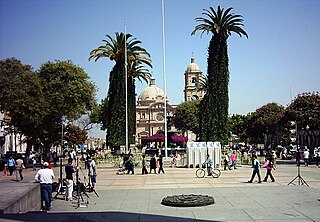
The Paseo Cívico de Tacna, formerly known as the Plazuela de la Matriz during the Spanish era and as the Plaza Colón from 1892 to 1957, is the main square of the historic centre of Tacna, Peru. It features landmarks such as the city's cathedral, the Monument to Heroes and the city fountain, delimited by San Martín Avenue.
Alonso Alegría Amézquita is a Peruvian playwright and theatre director. The son of journalist Ciro Alegría, he is known for his work in Nubeluz.